4.3 GILBERT S. VERNAM
Gilbert S. Vernam was an engineer for The American Telephone and Telegraph Company. He was asked in 1917 to develop a teletypewriter to perform on-line encipherment/decipherment. Alphanumeric plaintext was first coded into 0's and 1's using the Baudot code2, in which each character in a small alphabet is represented by a 5-bit sequence, as shown in Table 4.1. The key in Vernam's implementation of a rediscovered Vigenère polyalphabetic system was written on a paper tape as a sequence of five 0's and 1's and the Baudot-coded plaintext was XOR-ed with the key (Fig. 4.1). Vernam glued the ends of the paper tape into a loop, yielding additive encipherment with a periodic running key. Realizing that the strength of the encipherment would increase with the key length, Vernam combined several tapes with periods {ri} (Fig. 4.2). If the periods are properly chosen, a key formed from a total of Σi ri independently chosen key values could generate a key with period as large as R = Πi ri. Unfortunately, this way of making a large period R is not equivalent to a tape of length R [Tuckerman, 1970].
TABLE 4.1 Baudot Coding Table


Figure 4.1 Vernam's Teletypewriter Polyalphabetic Encipherment System (Courtesy of NSA).
Figure 4.2 Vernam's multitape polyalphabetic teletypewriter ...
Get Computer Security and Cryptography now with the O’Reilly learning platform.
O’Reilly members experience books, live events, courses curated by job role, and more from O’Reilly and nearly 200 top publishers.

